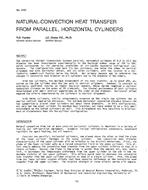Description
The convective thermal interactions between, parallel, horizontal cylinders of 0.2 in (5.2 mm) diameter has been investigated experimentally in the Rayleigh number range of 140 to 550, which corresponds to the operating conditions of air-cooled household refrigerator condensers. The configurations used were (1) two cylinders, one below the other in vertical alignment and with horizontal offset, and (2) three cylinders, with two located in a horizontally symmetrical fashion below the third. Our primary purpose was to determine the changes in convective heat transfer on all cylinders due to the presence of the others. With two cylinders, the maximum enhancement of the heat transfer, up to about 25%, occurred on the top cylinder when the two were in vertical alignment. However, in contrast to previously published results at higher Rayleigh numbers, these maxima required a vertical separation distance on the order of 20 diameters. The thermal performance of both cylinders deteriorated with small vertical separations on the order of one diameter. Horizontal offset negated the effects experienced by the cylinders in vertical alignment. With three cylinders, similar enhancements occurred on the single top cylinder but at smaller vertical separation distances. The optimum horizontal separation distance between the two symmetrically placed lower cylinders was about three diameters. In this configuration, not only had the upper cylinder its maximum heat transfer, but there seemed to be a very small enhancement on the bottom cylinders as well. This arrangement was less sensitive to misalignment or disturbances than the two-cylinder configuration.
Units: Dual
Citation: ASHRAE Transactions, 1987, vol. 93, pt. 2, Nashville, TN
Product Details
- Published:
- 1987
- Number of Pages:
- 16
- File Size:
- 1 file , 1.3 MB
- Product Code(s):
- D-NT-87-3100




